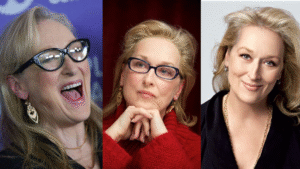The Heart Behind the Legend: Meet Meryl Streep
In a world that tells women they have limited time before becoming irrelevant, Meryl Streep did something revolutionary: She ignored the rules, trusted her craft, and became the most acclaimed actor of her generation.
Her story isn’t about overnight stardom or lucky breaks. It’s about quiet determination, exceptional talent, and the refusal to accept anyone else’s definition of her potential.
How a Shy Girl from New Jersey Became Cinema’s Greatest Chameleon
The Unexpected Beginning: Privilege Without Entitlement
June 22, 1949 – Mary Louise Streep was born in Summit, New Jersey, to a relatively privileged family. Her father, Harry Streep Jr., was a pharmaceutical executive. Her mother, Mary Wilkinson, was a former actress turned homemaker.
Unlike many Hollywood stories, Meryl’s beginning wasn’t marked by poverty or dramatic trauma. Instead, it was marked by something equally powerful: a mother who understood the arts and a father who valued education and excellence.
The Formative Years: Where It All Began
A Musical Household:
Her mother encouraged artistic pursuits
Piano lessons and voice training were normal
Theater and music filled their home
Education was prioritized above all else
Excellence was expected, not praised
The Shy Child Behind the Curtain:
Despite her artistic upbringing, Meryl was naturally shy
She wasn’t the outgoing, attention-seeking child
Preferred observing to performing
Struggled with self-confidence in social situations
Used acting as a way to explore identities beyond her own insecurity
The Discovery: In high school, Meryl discovered that acting allowed her to escape her shyness. When she was on stage, she wasn’t Mary Louise anymore. She could be anyone. She could explore human complexity safely behind a character.
This realization became her life’s purpose.
The Invisible Years: Training While Others Were Resting
College: Building the Foundation (1967-1971)
Meryl attended Vassar College, one of America’s most prestigious institutions. While her peers were enjoying college social life, Meryl was obsessing over her craft.
She didn’t just participate in theater—she lived it:
Took every acting class available
Performed in multiple productions each year
Studied Shakespeare intensively
Developed her understanding of character and emotion
Built discipline and work ethic that would define her career
The Realization: By graduation, Meryl understood something crucial: Talent alone isn’t enough. Only relentless training, study, and commitment creates mastery.
Yale Drama School: The Crucible of Excellence (1971-1973)
After Vassar, Meryl was accepted to Yale School of Drama, considered one of the finest acting programs in the world. This is where legends are forged.
The Yale Experience:
Studied under master teachers including Constance Cummings
Worked with future legends like Christopher Reeve and Kelsey Grammer
Performed in challenging classical works
Learned that good acting requires understanding human psychology
Developed her signature approach: deep research into character motivation
Key Insight: While most actors focused on how to perform emotions, Meryl focused on understanding why characters feel what they feel. This psychological depth became her trademark.
The Reality Check: Even after Yale, even with exceptional training, Meryl faced a harsh truth: being trained and being hired are different things.
The Struggle: Years of Rejection and Small Roles
Off-Broadway and Television (1973-1977)
After Yale, Meryl faced the same challenge every actor faces: Nobody knew who she was.
The Early Years:
Performed in off-Broadway productions
Small television roles in shows most people forgot
Earned minimal pay while working day jobs
Auditioned constantly, facing rejection regularly
Watched other actors become famous while she remained unknown
The Frustration: At this stage, many actors give up. They decide the dream isn’t worth the rejection, the poverty, the uncertainty. Meryl was tempted too.
But something in her refused to quit.
The Turning Point: In 1977, Meryl got her first significant film role in “Julia”. It was a small part, easily forgettable. But it was professional film work—a foot in the door.
Nobody predicted it would lead to legend status.
The Breakthrough: When Talent Finally Met Opportunity
“Kramer vs. Kramer” (1979): The Moment Everything Changed
In 1979, at age 30—an age when Hollywood considered women past their prime—Meryl was cast opposite Dustin Hoffman in “Kramer vs. Kramer.”
It was a modest film about a divorce and custody battle. Nothing spectacular on paper. But Meryl transformed it.
Her Performance:
Created a character of stunning complexity
Portrayed a working mother with nuance, not stereotypes
Showed vulnerability alongside strength
Made audiences feel her character’s pain without explaining it
Demonstrated a level of acting sophistication rarely seen in cinema
The Results Were Staggering:
Won the Academy Award for Best Supporting Actress
Earned critical acclaim from every major publication
Made industry insiders recognize a major talent
Changed how Hollywood perceived her overnight
The Real Significance: “Kramer vs. Kramer” proved that Meryl didn’t need to be young and pretty to be bankable. She could be complex, mature, and intelligent—and audiences would be captivated.
This realization transformed cinema.
The Golden Decade: Dominance Across All Genres
The 1980s: Unprecedented Success
Following “Kramer vs. Kramer,” Meryl’s career became extraordinary:
Multiple Masterpieces:
“The French Lieutenant’s Woman” (1981) – Challenging, complex role
“Sophie’s Choice” (1982) – Her most acclaimed role; won Academy Award for Best Actress
“Silkwood” (1983) – Political drama showcasing her range
“Out of Africa” (1985) – Epic romance

“Ironweed” (1987) – Gritty, unglamorous, powerful
“A Cry in the Dark” (1988) – Polarizing role that showed her fearlessness
Sophie’s Choice: The Pinnacle
“Sophie’s Choice” remains her most celebrated role. Playing a Polish Holocaust survivor burdened by impossible moral choices, Meryl created a performance of devastating power:
Learned the Polish language to add authenticity
Won the Academy Award for Best Actress
Critics called it one of the greatest performances ever captured on film
Proved she could carry an entire film’s emotional weight
Demonstrated her willingness to take on profoundly difficult material
The Recognition: By the late 1980s, Meryl wasn’t just a great actor. She was the standard against which all other actors were measured.
The 1990s: Expanding Range
Rather than rest on her accomplishments, Meryl continued pushing herself:
“Postcards from the Edge” (1990) – Comedy and drama blended
“Defending Your Life” (1991) – Comedy, adventure, philosophical depth
“Bridges of Madison County” (1995) – Romantic drama with surprising emotional resonance
“First Do No Harm” (1997) – Television work that showed she never felt above any medium
The Lesson: Meryl refused to be pigeonholed. She moved fluidly between genres, proving her genius wasn’t limited to serious drama. She could do comedy, romance, action—anything.
The 2000s and Beyond: Reinvention Without Aging Out
As Meryl entered her 50s and 60s—ages when most actresses fade from prominence—she did something remarkable: She became more powerful.
Cultural Phenomenon Roles:
“The Devil Wears Prada” (2006) – Became a global pop culture touchstone; played fashion industry power broker
“Mamma Mia!” (2008) – Sang, danced, and proved she could do musical comedy
“Doubt” (2008) – Returned to serious drama opposite Meryl Streep; nominated for Academy Award
“Into the Woods” (2014) – Musical drama, complex character
“The Iron Lady” (2011) – Won Academy Award playing Margaret Thatcher at age 62
The Unprecedented Achievement: Meryl became the first actor to win three Academy Awards. But more importantly, she proved that aging in Hollywood doesn’t mean becoming irrelevant.
Instead, she became more powerful, more interesting, and more sought-after.
Recent Triumphs (2015-Present)
Even in her 70s, Meryl continues to dominate:
“Ricki and the Flash” (2015) – Rock musician mother
“Florence Foster Jenkins” (2016) – Aging opera singer
“The Post” (2017) – Journalist fighting for free press
“Little Women” (2019) – Older mentor character
“Mank” (2020) – Hollywood history
“Don’t Look Up” (2021) – Science fiction satire alongside top actors
The Secret Behind Meryl’s Immortal Success
Lesson 1: Deep Research Creates Authenticity
Meryl doesn’t just memorize lines. She becomes the character:
For “Sophie’s Choice,” she learned Polish
For “The Iron Lady,” she studied Margaret Thatcher obsessively
For “A Cry in the Dark,” she researched the true story extensively
She understands not just what characters do, but why they do it
The Result: Her performances feel inevitable, authentic, true.
Lesson 2: Intelligence Is as Important as Talent
Meryl reads voraciously. She understands literature, history, psychology, and human nature. This intellectual depth informs every character choice.
She doesn’t just play emotions. She understands the psychology underlying those emotions.
Lesson 3: Never Let Age Define You
When Hollywood stopped offering her roles, Meryl didn’t disappear. She became more selective, more powerful, and more relevant.
She proved that maturity isn’t a liability—it’s an asset. Life experience creates depth no younger actor can match.
Lesson 4: Take Risks on Unconventional Roles
Playing villains (The Devil Wears Prada)
Singing in musicals (Mamma Mia!)
Doing comedy (Defending Your Life)
Playing real people with controversial legacies (Margaret Thatcher)
These choices could have failed. Instead, they demonstrated her fearlessness and range.
Lesson 5: Craft Is Everything
Meryl never relied on beauty, sex appeal, or star power. She relied on exceptional craft.
Even at 70, when beauty fades, craft endures. Her performances at 70 are as powerful as her performances at 30 because she’s spent 50 years perfecting her art.
The Awards and Recognition: By the Numbers
Academy Awards:
3 wins (more than any other actor)
21 nominations (more than any other actor)
Recognition across six decades
Golden Globes:
8 wins
31 nominations
Emmy Awards:
Multiple wins for television work
BAFTA Awards:
Multiple wins and nominations
Other Honors:
Presidential Medal of Freedom
Kennedy Center Honors
Countless international film festival awards
Ranked among “Greatest Actors of All Time” by virtually every major film publication
The Real Measure: These aren’t just trophies. They represent consistent, unrelenting excellence across five decades.
The Personal Journey: A Woman’s Life in Hollywood
Marriage and Family
Don Gummer:
Met and married stage manager Don Gummer in 1978

Their marriage has lasted 45+ years
Raised four children together
Maintained her professional identity while being a mother
Navigating Motherhood and Career: Unlike many actresses forced to choose between family and career, Meryl did both. She didn’t hide her children or pretend they didn’t exist.
Activism and Voice
Beyond acting, Meryl has used her platform:
Advocated for women in film and equality
Spoken out on political issues
Supported causes she believes in
Used her voice despite risk to her career
Mentored younger actors, especially women
The Grace of Aging
In an industry obsessed with youth, Meryl demonstrated a revolutionary concept: Aging can be powerful.
She didn’t fight aging or disappear when youth faded. She accepted aging and became more interesting. Her lines became part of her character. Her gray hair became her crown.
The Legacy: More Than Just Movies
Redefining Female Success
Meryl didn’t just have a successful career. She redefined what success means for women in Hollywood:
Proved women can be bankable past 40, 50, 60, 70
Showed that intelligence is as marketable as beauty
Demonstrated that complex, flawed characters are more interesting than perfect ones
Proved that motherhood and career aren’t mutually exclusive
Showed that aging is a source of power, not irrelevance
Influencing an Industry
Every female actor working today is influenced by Meryl’s example:
She showed it’s possible to refuse mediocre roles
She demonstrated that saying “no” to bad scripts is better than saying “yes”
She proved that versatility is valuable
She showed that technical excellence never goes out of style
Setting a Standard
In an industry that values youth, beauty, and sex appeal, Meryl proved that talent, intelligence, and craft are superior.
Her success created space for other serious actors. She proved there was an audience for complex, intelligent cinema.
The Journey: Before & After
AspectThe Struggling Actress (1973-1978)The Legend (1980-Present)
Recognition
Unknown, struggling
Most celebrated actor of her generation
Financial Status
Barely earning
Commanding $15-20M+ per film
Roles Available
Small, forgettable parts
Choosing from elite scripts
Industry Respect
Unproven
Standard-setter
Age Advantage
Youth expected
Maturity is her power
Film Quality
Any role she could get
Only exceptional scripts
Awards
None
3 Oscars, 8 Golden Globes
Cultural Impact
Minimal
Global influence
Opportunities
Limited
Unlimited
Legacy
Unknown future
Immortalized in cinema
The Bottom Line: Why Meryl’s Story Matters
Meryl Streep didn’t become great because she was the most beautiful actress. She wasn’t. She didn’t become great because she started as a child star. She didn’t. She didn’t become great because she had powerful connections. She didn’t.
She became great because:
✓ She trained relentlessly ✓ She studied her craft obsessively ✓ She refused mediocre roles ✓ She took intelligent risks ✓ She aged gracefully instead of fighting aging ✓ She used her intelligence as her superpower ✓ She proved that complexity is more interesting than beauty ✓ She showed that longevity comes from craft, not youth ✓ She demonstrated that women can define their own success ✓ She proved that saying “no” to bad opportunities creates space for great ones
Key Takeaways for Artists and Dreamers
🎭 Talent alone isn’t enough; craft requires relentless training 🎭 Intelligence is as important as natural ability 🎭 Refusing mediocrity is more important than accepting everything 🎭 Aging can be a source of power, not decline 🎭 Complexity is more interesting than perfection 🎭 Deep research creates authentic performances 🎭 Versatility proves that genius isn’t limited to one genre 🎭 Technical excellence never becomes obsolete 🎭 Your worth isn’t determined by your age or appearance 🎭 True success is built over decades, not overnight
Meryl’s Defining Words
“It’s bizarre that the produce manager is more important to my children than I am, but that’s the reality of my life. I’d rather be a really good mom than a famous actress.”
“The interesting thing about being a writer, actor, or musician is that you have to connect with human emotion. You can’t do anything without understanding the human heart.”
“You have to embrace getting older. Life is either getting better or you’re dying, so you have to embrace getting older.”
The Continuing Evolution
At 75 years old, Meryl continues to work, choose exceptional projects, and influence the industry. She hasn’t retired because her craft hasn’t diminished. If anything, her understanding of human nature has deepened.
This is the real Meryl Streep story:
Not a woman who became a star and faded. But a woman who committed to her craft and became immortal through the power of great acting.
She proved that the greatest success isn’t fame. It’s the creation of art so powerful it transcends time.
Her performances will be studied, admired, and learned from for generations. That’s a legacy money can’t buy and age can’t diminish.
That’s the power of Meryl Streep.



